Mapping Democracy
| Attachment | Mida |
|---|---|
| Mapping Democracy | 3.09 MB |
Organization
Introduction
The rise of digital communication technologies has placed new emphasis on an old problem: that of information overload. Information overload refers to an amount of information in excess of what individuals are able to process and absorb. [1] Different strategies are deployed to counter this trend, including the use of search engines to filter information. [2] Where engines look to create ordered lists of relevant sources, the strategy of visualising information aims to give an overview of a particular data set, or make certain relationships visible. In this way, mapping and visualising data sets are means by which information can be made more accessible and useful.
Communication and information dissemination are important aspects of networking, advocacy capacity, and the reach and impact of civil society organisations. Mapping and visualising information provides a way for civil society organisations to enable individuals, communities, networks and governments to process and absorb information easily. Important information disseminated in this way can become more accessible for more people. Therefore mapping and visualising information can be used as a communication, advocacy [3] and research [4] tool.
This chapter will demonstrate how information can be visualised on the basis of two research examples from the Digital Methods Initiative (DMI), “The Nationalities of Issues: Rights Types” and “For the ppl of Iran - #iranelection RT”. The first looks at the most significant rights types per country according to local Google results when entering “rights” in the local language. The latter looks at Twitter during the 2009 Iran election crisis.
DMI Amsterdam is a collaboration of the New Media programme, Media Studies, University of Amsterdam and the Govcom.org Foundation. The initiative is dedicated to reworking methodologies for internet research, and in particular to learning and developing techniques for studying societal conditions and cultural change using the web.
Social research with the web
We look at Google results and see society, instead of Google. That is a shorthand way of saying that we see institutions and issues in the ranked lists that are returned in the search results. Query the word “rights” in Google.com and you are returned with the top websites in the English-language space dealing with rights, in a variety of ways. You can also see which rights types are higher than others. For example, lesbian, gay, bisexual and transgender (LGBT) rights appear in the top ten in Google.com, but not in Google.fr, where youth rights are much higher.
But the question that is often asked is, where does social research end, and “Google studies” begin? Isn’t it Google that determines the rankings? Surely Google has more to do with the hierarchies than societal dynamics? Can Google ever be removed from the picture when one is using it to perform research? These questions are classic ones in social research, as they concern the possibility of being able to isolate phenomena dependent on a context for them to exist. However, this question should also be put to web studies more generally: Does one only study the web when you use the web?
The two research projects presented are attempts at web studies where the tool used (e.g., Google or Twitter) is part of the analysis. In doing this, one is always aware of the significance of the question of where Google studies end, and social research using Google begins.
What kinds of findings may be made by interpreting search engine results, especially the rankings of sites for particular queries? What kinds of findings can be made by comparing results across the many local versions of Google, such as the new Palestinian one, Google.ps? In the project “The Nationalities of Issues: Rights Types”, we entered the word “rights” in various languages into the local Googles in order to obtain hierarchies of rights types per country. Are there distinctive rights that rise to the top in Finland, the Netherlands, France, Italy, Switzerland, Germany, Austria, Sweden, Russia, Japan, Canada, the United Kingdom, Australia, the Philippines, Ivory Coast and other countries? As the results show, the answer is yes. From “cultural rights” in Mexico, “pollution victims’ rights” in Switzerland, the “right to education in a native sign language” in Finland, to “rights of the over-indebted” in Ivory Coast, countries could be said to have distinctive concerns, compared to other countries, as read from local Google results.
Twitter, generally, but also during the Iran election crisis (June 2009 and beyond), has been described as banal. The question is, could the hundreds of thousands of tweets about the Iran election crisis be made into a comprehensible account of what has been happening on the ground as well as online? The project, “For the ppl of Iran - #iranelection RT”, is such an attempt. In order to filter the most significant tweets, and order them so as to recount the crisis, the digital methods researchers chose to assemble the top three “retweets” per day, and order them chronologically, from 10 June to 30 June. The resulting output is a capsule account of the crisis, which the researchers also subsequently edited, and made into sub-storylines, on arrests, violence, the death of Neda Agha Soltan, [5] censorship as well as the internet. The entire set of the top three retweets with the #iranelection hash tag from 10-30 June 2009 is printed. The sub-threads are online at www.rettiwt.net (requires issuecrawler.net login).
The Nationalities of Issues: Rights Types
Most significant rights types per country according to local Google results of the query for “rights” in the local languages.
RESEARCH STRATEGY:Employ Google to show most prominent types of rights per country.
METHOD:Query the term “rights” in the local languages in the local Google versions (e.g., “oigused” in Google.ee and “direitos” in Google.pt). Manually read the results and make lists of the top ten distinctive rights types, leaving them in the order that Google provided.
Google.se with query “rattigheter” (13.07.09)
Google.fi with query “oikeudet” (13.07.09)
Google.ee with query “oigused” (15.07.09)
Google.lv with query “tiesibas” (16.07.09)
Google.co.uk with query “rights” (13.07.09)
Google.nl with query “rechten” (13.07.09)
Google.be with query “rechten van” (15.07.09)
Google.be with query “droits” (14.07.09)
Google.lu with query “rechte” (15.07.09)
Google.de with query “rechte” (15.07.09)
Google.at with query “rechte” (15.07.09)
Google.ch with query “rechte” (15.07.09)
Google.fr with query “droits” (14.07.09)
Google.pt with query “direitos” (14.07.09)
Google.es with query “derechos” (13.07.09)
Google.it with query “diritto al” OR “diritto all” OR “diritto alla” (13.07.09)
Google.ro with query “drepturile” (13.07.09)
Google.mo with query “drepturile” (13.07.09)
Google.ru with query “prava” (13.07.09)
Google.com.tr with query “haklari” (17.07.09)
Google.jp with query “権적” (16.07.09)
Google.hk with query “權적” (17.07.09)
Google.com.ph with query “karapatang” (16.07.09)
Google.ci with query “droits” (17.07.09)
Google.com.au with query “rights” (14.07.09)
Google.ca with query “rights” (15.07.09)
Google.ca with query “droits” (15.07.09)
Google.com with query “rights” (14.07.09)
Google.com with query “derechos” (15.07.09)
Google.com.mx with query “derechos” (15.07.09)
Google.com.br with query “direitos” (15.07.09)
Google.ar with query “derechos” (15.07.09)
Google.pe with query “derechos” (15.07.09)
Note that the local Google versions were chosen on the basis of the language skills of the participants of the Digital Methods Summer School, 2009. At the same time, when faced with a large quantity of Google versions for a single language, a further selection was made (e.g., the top three Spanish-speaking countries according to population).
For those local Google versions where multiple languages are spoken, the two dominant languages were queried (e.g., we queried google.be [Belgium] in Flemish and French, and queried google.ca [Canada] in English and French).
DATA STORAGE:The top 100 results per query are stored for validation purposes. (In Firefox, “save page as”, “web page, complete”.) Data sets are available at wiki.digitalmethods.net/Dmi/NationalityofIssues.
FINDINGS: Countries could be said to have distinctive concerns, compared to other countries, as read from Google results. For example, “everyman’s right” (the freedom to roam) in Finland, “prostitutes’ rights” in the Netherlands, “computer programmers’ rights” in Japan and the “right to oblivion” (the right to have personal data deleted) in Italy are unique to the respective countries. [6] Given the limited sample of countries and the method for selection, the most widely shared rights across countries are not the subject of analysis.
DESIGN: Vera Bekema and Anne Helmond.
ANALYSIS: Vera Bekema, Liliana Bounegru, Andrea Fiore, Anne Helmond, Simon Marschall, Sabine Niederer, Bram Nijhof, Richard Rogers and Elena Tiis.
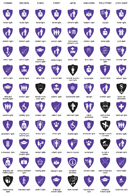 |
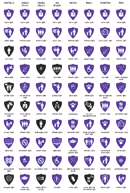 |
| download pdf | download pdf |
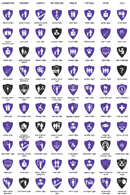 |
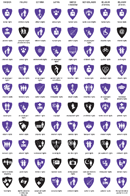 |
| download pdf | download pdf |
| Right type | |
| Right type unique to the country (in this sample) |
For the ppl of Iran - #iranelection RT
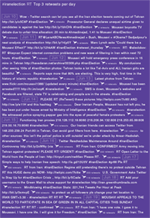
#iranelection RT tells the story of the day-to-day unfolding of the Iran election crisis as seen through Twitter. #iranelection RT is a collection of all the tweets that have been tagged #iranelection, from the first one on 10 June up to 30 June 2009, some 650,000 in all. The most retweeted tweets (RTs) have been filtered and organised chronologically, as opposed to the reverse chronology that Twitter uses. In “reversed realtime”, the most significant #iranelection retweets show the urgency and the emotion of those twenty days in June, when the tensions on the streets and the coverage in the media were at their height. The crisis unfolds on Twitter with the discovery of the value of the #iranelection hash tag, and tweeters both in and outside Iran begin using it to mark all tweets about the events there: the opposition candidate Mir-Hossein Mousavi holds an emergency press conference; the voter turn-out is 80%; Mousavi’s website and Facebook page are blocked; police using pepper spray; Mousavi is under house arrest, and declares he is prepared for martyrdom; Neda is dead; there is a riot in Batherstan Square; Bon Jovi sings “Stand by Me” in support; Ahmadinejad confirmed the winner, and so on.
The collection of tweets also shows how tweeters respond to what is happening online and on the ground. Tweets reporting important websites that have been blocked are followed up by proxies being offered. Accounts of police using pepper spray are followed up by links to websites with first aid information.
DATA BREAKDOWN (10-30 June 2009):
Tweets tagged with #iranelection: 653,883
Unique number of Twitter users using #iranelection tag: 99,811
Number of Twitter users using #iranelection with multiple tweets: 46,702
Number of Twitter users using #iranelection with greater than 20 tweets: 6,000
Number of Twitter users using #iranelection with 1 tweet: 53,109
Number of Twitter users using #iranelection who were retweeted: 36,913
Number of Twitter users using #iranelection who were retweeted multiple times: 16,336
Number of Twitter users using #iranelection who were retweeted 10 times or more: 2,829
Number of Twitter users using #iranelection who were retweeted 1 time: 20,577
Number of languages used in #iranelection: 26
Number of tweets in #iranelection in English: 612,373
Number of tweets in #iranelection in Farsi: 6,248
DESIGN AND ANALYSIS: Programming by Erik Borra, design by Marieke van Dijk and editorial by Richard Rogers, Kimberley Spreeuwenberg and Esther Weltevrede.
FURTHER INFORMATION: #iranelection RT is online at www.rettiwt.net (requires issuecrawler.net login).
Notes
[1] Yang, C.C., Chen, H. and Honga, K. (2003) Visualization of large category map for Internet browsing, Decision Support Systems 35 (1), p. 89-102.
[2] Google's mission statement is “to organize the world's information and make it universally accessible and useful.” ">www.google.com/corporate
[3] A good example is Ushahidi, a Kenyan organisation that has its origin in the mapping of reports of violence in Kenya after the post-election fallout at the beginning of 2008. www.ushahidi.com
[4] For example, Govcom.org is dedicated to creating and hosting political tools on the web. Much of the work involves mapping issue networks on the web. www.govcom.org
[5] Shot to death on 20 June 2009 by security forces during a protest.
[6] Given our commitment to reading society on the web, as well as to preserving the cultural distinctiveness of the rights found, classic social science methods (such as categorising findings for easier comparison) as well as attempts to rephrase or correct the language of rights types were resisted (e.g., translating "jokamiehenoikeus", which the Finnish translate as "everyman's right", to "every person's right", or regarding lesbian, gay, bisexual and transgender [LGBT] rights in the United States and homosexual rights in Hong Kong as equivalents).